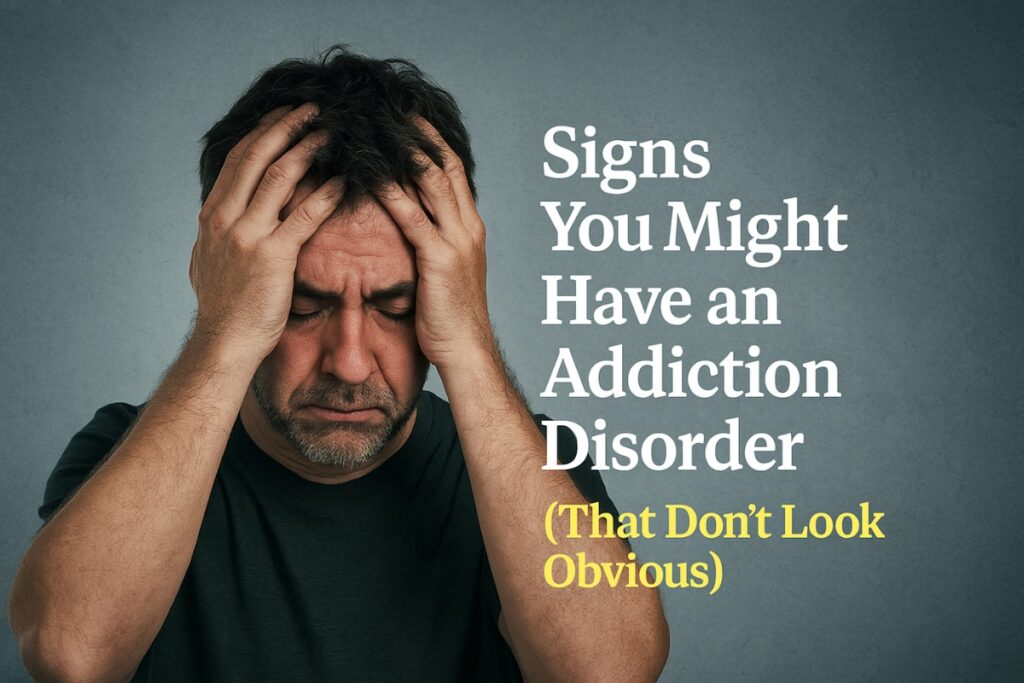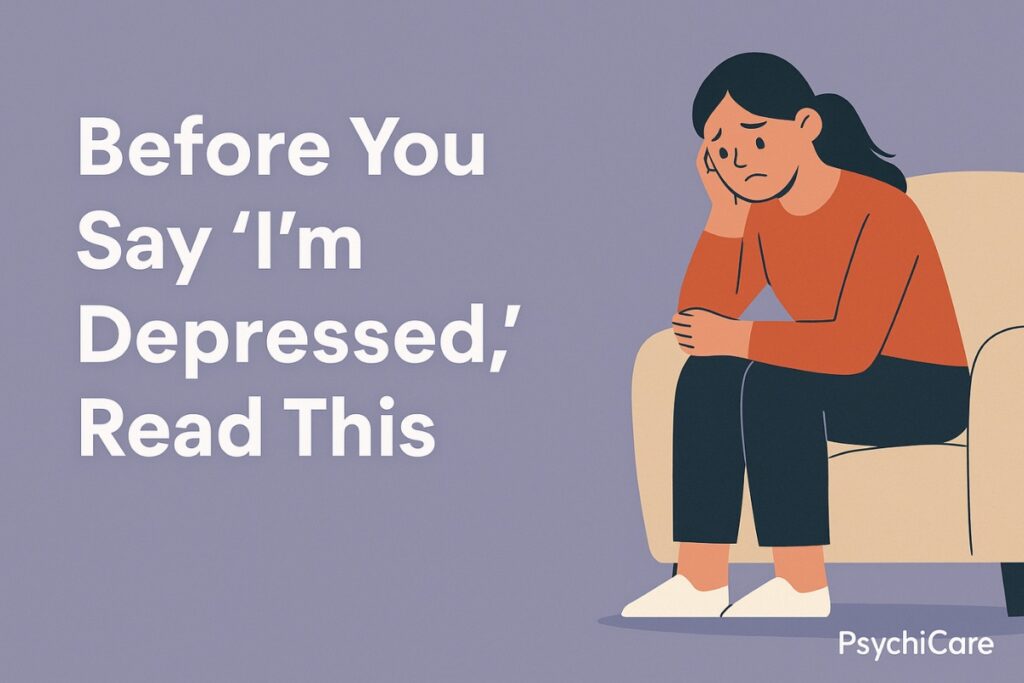Updated: October 2025 · Information refreshed to reflect recent research and best practices.
You feel trapped in your own head.
A thought you don’t want shows up, and suddenly you can’t let it go. You check, you repeat, you clean, you scroll, just to feel a little relief. But the relief never lasts.
If this sounds familiar, you’re not alone. In 2025, OCD (Obsessive-Compulsive Disorder) affects about 2–3% of people worldwide, yet most struggle in silence for years before getting help. In India, experts report that fewer than one in four people with OCD receive proper treatment, often because the condition is mistaken for perfectionism, overthinking, or just “being too neat.”
So what exactly is OCD?
OCD is a mental health condition where unwanted thoughts (obsessions) trigger intense anxiety, and repetitive behaviors or mental rituals (compulsions) are used to try to control that anxiety. It’s not just about germs or tidiness, it can show up in relationships, schoolwork, spirituality, even the way your body feels.
This guide will break down what OCD really is in 2025, the symptoms, causes, types, myths, and treatments, plus new research and tools that make recovery more possible than ever.
What Is OCD (and What It Isn’t)?
You’ve probably heard someone say, “I’m so OCD about my desk” as if OCD just means being tidy. But that’s a myth. OCD is not a personality quirk. It’s a serious mental health condition that can take over hours of someone’s day.
Obsessive-Compulsive Disorder (OCD) is defined by two key parts:
- Obsessions: intrusive, unwanted thoughts, images, or urges that cause distress.
- Compulsions: repetitive behaviors or mental rituals done to neutralize that distress.
For example:
- Obsession: “What if I left the stove on and the house burns down?”
- Compulsion: checking the stove again and again, even when you know it’s off.
OCD doesn’t always look like handwashing or organizing. In 2025, therapists see more digital-age compulsions:
- Re-reading texts to make sure you didn’t offend someone.
- Scrolling Instagram repeatedly to compare yourself with others.
- Asking AI chatbots or friends the same question for reassurance.
What OCD Isn’t
- It isn’t just being neat or detail-oriented.
- It isn’t simply “worrying too much.”
- It isn’t something you can “just stop.”
OCD is recognized in the DSM-5 as a distinct disorder, different from perfectionism or general anxiety.
OCD Symptoms You Should Know
OCD is not just about washing hands or keeping things clean. Its symptoms are complex, often invisible, and can change form over time. Clinicians describe them as obsessions (unwanted thoughts or urges) and compulsions (actions or mental rituals done to relieve the anxiety).
Obsessions in 2025: The Hidden Triggers
Obsessions are not random, they latch onto whatever you value most. That’s why they feel so disturbing. Common themes include:
- Digital doubts: rereading WhatsApp or email messages dozens of times, terrified you offended someone.
- Harm fears: sudden intrusive images like “What if I push this person in front of a train?” even if you never would.
- Contamination in new forms: not just germs, fears about food additives, radiation from devices, or “toxic” online energy.
- Relationship doubts (ROCD): replaying every interaction with your partner, asking, “Do I really love them?”
- Moral or religious guilt (Scrupulosity): obsessing over whether you sinned, lied, or offended God—even in harmless situations.
- “Just Right” feeling: a gnawing sense that something is incomplete, your shirt feels wrong, a word sounds off, a thought isn’t “settled.”
Compulsions: Old Rituals, New Formats
Compulsions are the brain’s attempt to “fix” the obsession but they only strengthen the cycle. In 2025, compulsions often look like:
- Reassurance loops: texting friends, searching Google or even asking ChatGPT the same “Am I okay?” question repeatedly.
- Digital checking: refreshing social media likes or re-opening apps until it feels “safe.”
- Mental compulsions: silently praying, repeating words, replaying conversations to make sure nothing “bad” happened.
- Physical rituals: tapping, re-arranging, or repeating tasks until the sensation feels “just right.”
- Avoidance: refusing to touch, say, or think about anything linked to the obsession (e.g., skipping relationships, exams, or even parenting tasks).
When to Recognize It as OCD
Normal worries fade. OCD symptoms feel different:
- They take over an hour a day (often much more).
- They feel ego-dystonic, you know they don’t make sense, but you can’t stop.
- They cause guilt, shame, or exhaustion because you realize the cycle controls you.
👉 This is why many people don’t realize they have OCD, it’s not just about what others can see. Much of it happens silently, in the mind.
What Causes OCD in 2025?
OCD doesn’t have one single cause. Instead, researchers now see it as a mix of brain wiring, genetic vulnerability, thought patterns, and environmental triggers. In 2025, we also know how technology, culture, and modern stressors fuel the cycle.
Brain Circuits and Neurochemistry
Brain scans show OCD is linked to overactive loops between the orbitofrontal cortex, anterior cingulate, and striatum areas that control decision-making and threat detection. It’s like the brain’s “alarm system” keeps firing even when there’s no real danger.
- Neurotransmitters like serotonin and dopamine are involved, which is why SSRIs often help.
- Newer studies also point to glutamate imbalance as a factor, leading to trials of glutamate-modulating drugs.
Genetics and Family Risk
OCD often runs in families. If a parent or sibling has OCD, your risk is higher. But genes aren’t destiny, they only raise sensitivity. Environment and experiences decide whether symptoms appear.
Cognitive Styles and Thought Traps
Psychologists note people with OCD often struggle with:
- Intolerance of uncertainty → needing 100% proof things are safe or true.
- Inferential confusion → treating a “what if” thought as if it were already fact.
- Perfectionism and over-responsibility → believing “If I don’t stop this, something bad will happen.”
Cultural and Social Media Triggers (2025 Realities)
Modern life feeds OCD in new ways:
- Social media comparisons amplify intrusive doubts (about looks, relationships, careers).
- News cycles and pandemics reinforce contamination fears.
- Dating apps fuel ROCD (“Did I swipe past my soulmate?”).
- Family and cultural expectations in India such as arranged marriage, academic pressure, or religious rules can intensify obsessive doubts and guilt.
👉 In short: OCD is not caused by weakness. It’s a condition where brain sensitivity + thought patterns + cultural triggers combine to trap you in the cycle.
Types of OCD – Beyond the Usual Four
Most websites say there are four main types of OCD: contamination, checking, symmetry, and intrusive thoughts. That’s true, but it’s only part of the story. In 2025, clinicians talk more about symptom dimensions and subtypes, because OCD is rarely one-size-fits-all.
The Four Core Dimensions
- Contamination & Cleaning → Fear of germs, dirt, or illness. Compulsions include washing, disinfecting, or avoiding “unclean” spaces.
- 2025 example: excessive sanitizing even after COVID, refusing to touch cash or public transport handles.
- Checking & Responsibility → Fear of causing harm through mistakes or negligence.
- 2025 example: repeatedly checking emails for a typo that might “ruin your career,” or checking if GPS location-sharing is “still on” for a loved one’s safety.
- Symmetry & “Just Right” → Needing balance, order, or completeness.
- 2025 example: rewriting notes until the spacing feels perfect, or rearranging apps on your phone until the grid “feels right.”
- Intrusive / Unacceptable Thoughts → Disturbing, taboo, or violent thoughts that go against your values.
- 2025 example: sudden mental images of harming your child, sexual thoughts about someone inappropriate, or blasphemous thoughts during prayer.
Subtypes You May Not Know
- Relationship OCD (ROCD) → Endless doubts about whether you love your partner, or if they’re “the one.” Triggers often come from dating apps and social media comparisons.
- Scrupulosity (Moral/Religious OCD) → Obsessions about sinning, lying, or being immoral. In India, this may show up as repeating pujas or prayers until they feel “pure.”
- False Memory / Real Event OCD → Obsessing over whether you did something terrible in the past (or misremembering events).
- Example: “What if I cheated and don’t remember?”
- Sensorimotor / Somatic OCD → Hyperawareness of automatic body functions like blinking, breathing, swallowing.
- Hoarding OCD → Difficulty discarding even useless items, fearing something bad will happen if you do.
- Existential OCD → Getting stuck on unanswerable questions like “What’s the meaning of life?” or “Am I even real?”
hifting Themes Over Time
One of the hardest parts of OCD is that themes can change. Someone may start with contamination fears, then later develop ROCD or intrusive harm thoughts. The content shifts, but the cycle—obsession → anxiety → compulsion → temporary relief—remains the same.
👉 Knowing these dimensions and subtypes helps you spot OCD in all its forms, not just the stereotypes.
OCD vs Similar Conditions
OCD often hides behind labels like “I’m just anxious” or “I’m a perfectionist.” But understanding the differences matter because treatment is different too.
OCD vs OCPD (Obsessive-Compulsive Personality Disorder)
- OCD = ego-dystonic → thoughts/rituals feel unwanted and distressing.
- OCPD = ego-syntonic → perfectionism and control feel “right,” even if they cause problems.
👉 Example: An OCD patient hates checking the lock 20 times but can’t stop. Someone with OCPD may proudly believe “the lock must be checked 20 times or it’s sloppy.”
OCD vs General Anxiety Disorders
- Anxiety = future-oriented worry (“What if I fail tomorrow’s test?”).
- OCD = intrusive loop + ritual (“What if I failed already? Let me re-check my paper 10 times”).
👉 Key sign: OCD comes with compulsions, behaviors or mental acts meant to “fix” the thought.
OCD vs ADHD / Autism (Neurodivergence)
- ADHD = distractibility, impulsivity, trouble finishing tasks.
- OCD = hyperfocus, repeating tasks until they feel perfect.
- Autism = routines and order for comfort.
- OCD = rituals to neutralize anxiety or intrusive thoughts.
👉 Overlap: Many people have both, but in OCD the behaviors feel driven by fear, not comfort.
OCD vs Perfectionism
- Perfectionism = high standards; can push productivity (until burnout).
- OCD = compulsions to avoid feared disaster, even if irrational.
👉 Example: A perfectionist may rewrite an email for style. A person with OCD may reread it 50 times, terrified they made a mistake that will “ruin everything.”
Tip: If your habits cause distress, shame, or lost time, it’s more than perfectionism or anxiety, it may be OCD.
How OCD Is Diagnosed in 2025
Getting an OCD diagnosis isn’t about one quick blood test, it’s about patterns, severity, and impact on daily life. In 2025, clinicians use both structured tools and lived experience to make an accurate call.
DSM-5 Criteria Simplified
To meet the diagnosis, obsessions and/or compulsions must:
- Feel intrusive and unwanted.
- Take more than an hour a day or cause major distress.
- Not be better explained by another disorder (e.g., GAD, autism).
Modern Tools and Scales
- Y-BOCS (Yale-Brown Obsessive Compulsive Scale): gold standard for rating severity.
- DOCS (Dimensional Obsessive-Compulsive Scale): breaks symptoms into contamination, responsibility, incompleteness, and taboo thoughts.
- Online self-checks & quizzes: widely used now, but only as screening tools.
👉 In 2025, many clinics (including in India) let you complete digital screening forms before your first appointment, reducing delays in diagnosis.
When to Seek Professional Help
- If symptoms eat up >1 hour a day.
- If they interfere with work, school, or relationships.
- If you feel shame or secrecy around rituals.
- If compulsions “work” less and less, but you can’t stop.
💡 Many people wait years, thinking their OCD isn’t “bad enough.” But early help means better recovery chances.
Treatment Options for OCD in 2025
OCD is treatable. While it may not “disappear overnight,” the right therapies can break the cycle and give you your life back. In 2025, treatment combines gold-standard methods with new digital tools that make support more accessible.
ERP: Exposure and Response Prevention
- The most effective treatment.
- Teaches you to face obsessions without doing compulsions.
- Example: touching a “contaminated” doorknob and resisting the urge to wash.
- Over time, your brain learns that anxiety fades on its own.
CBT: Cognitive Behavioral Therapy
- Focuses on thought patterns fueling OCD.
- Works on reducing guilt, catastrophic thinking, and perfectionism.
Medication
- SSRIs (like fluoxetine, sertraline) remain first-line.
- Clomipramine may be used for severe cases.
- Research in 2024–25 explores glutamate-modulating drugs for resistant OCD.
Digital & AI Therapy in 2025
- Telehealth ERP programs are now widely available in India and globally.
- Apps like NOCD and Wysa guide exposure practice and offer therapist check-ins.
- AI chatbots can help track triggers, though privacy remains a concern.
💡 OCD recovery is possible. With the right support, symptoms can reduce significantly, and many people reach long-term remission.
➡️ For a full breakdown of therapy, meds, and costs, see our detailed guide: OCD Treatment in 2025.
Can OCD Be Cured Permanently?
One of the most Googled questions about OCD is: “Can it be cured forever?” The honest answer: OCD is highly treatable, but it’s usually managed rather than “cured” in the way we think of an infection or injury.
Recovery vs. Cure
- Cure suggests OCD disappears completely and never returns.
- Recovery means symptoms no longer control your life, you may still get intrusive thoughts, but you don’t spiral into compulsions.
👉 Many people live in long-term remission after therapy and medication. The intrusive thoughts may visit, but they no longer stick.
Remission and Relapse
- With ERP + medication, up to 60–70% of people see major improvement.
- Relapses can happen—often during stress, big life changes, or stopping treatment suddenly.
- The difference in 2025: early digital support and relapse-prevention tools help people bounce back faster.
Stories of Hope
- In India, ERP combined with tele-therapy has allowed students, working professionals, and parents to resume normal life after years of being “stuck.”
- Global studies show that with continued practice, people often report “OCD no longer defines me, it’s just background noise.”
💡 Instead of thinking in terms of cure, think of OCD like asthma or diabetes: with the right management, you can live fully, even if the condition exists in the background.
➡️ For a deeper dive into recovery stories, see our blog: Can OCD Be Cured Permanently?
Living With OCD in 2025
OCD doesn’t just happen in your head, it affects your relationships, career, family, and even how you use technology. The good news? In 2025, people have more tools and support than ever before.
Impact on Daily Life
- Work & School: Perfectionism and checking rituals slow productivity; intrusive thoughts distract during meetings or exams.
- Relationships: ROCD doubts, constant reassurance-seeking, or compulsive texting can strain partners.
- Family Dynamics: Parents may unknowingly accommodate rituals (“I’ll check the lock for you”), which reinforces the cycle.
Coping Skills That Actually Help
OCD management is about building tolerance for uncertainty, not chasing 100% certainty. Some tools people use in 2025 include:
- Mindfulness training: observing intrusive thoughts without acting on them.
- Journaling prompts: writing “What my OCD told me today vs. what’s actually true.”
- Digital detox: limiting late-night Googling or compulsive reassurance searches.
- Micro-exposures: practicing small, daily challenges like leaving a typo in a text.
Support Systems in 2025
- Apps & AI tools: Apps like NOCD (ERP guidance) or Wysa (chat support in India) help track rituals and progress.
- Online support groups: Communities on Reddit, Discord, and Indian mental health forums reduce isolation.
- Therapist accessibility: Telehealth + hybrid ERP therapy makes specialized OCD treatment available even outside big cities.
💡 Living with OCD doesn’t mean giving up your future. With treatment and support, OCD can move from being the center of your life to just background noise.
Myths & Misunderstandings About OCD
Even in 2025, OCD is one of the most misunderstood mental health conditions. These myths add to stigma and stop people from seeking help.
Myth 1: OCD Is Just About Germs and Cleaning
Yes, some people struggle with contamination fears. But many others never wash excessively. Their OCD shows up in doubts, intrusive thoughts, or mental rituals invisible to others.
Myth 2: OCD Equals Perfectionism
Perfectionists like things neat; people with OCD feel forced to repeat tasks until it feels “safe.” One boosts productivity, the other steals hours of life.
Myth 3: OCD Means Weakness or Lack of Willpower
People with OCD often know their fears are irrational. The problem isn’t willpower, it’s how the brain’s alarm system misfires. With treatment, the cycle can be retrained.
Myth 4: Intrusive Thoughts Mean You Secretly Want Them
This is one of the most painful misconceptions. Someone with harm OCD may picture stabbing a loved one but the thought horrifies them. Intrusive thoughts are the opposite of desires.
Myth 5: OCD Can Be “Snapped Out Of”
Telling someone “just stop thinking about it” is like telling someone with asthma to “just breathe.” OCD requires therapy, support, and often medical treatment, not quick fixes.
💡 Debunking myths matters. When people realize OCD is more than neatness, shame lifts and real conversations about treatment can begin.
Final Thoughts
OCD can make you feel like you’re fighting your own mind. The more you try to silence the thoughts, the louder they get. The more you do the rituals, the more trapped you feel. But here’s the truth: OCD is treatable, and recovery is real.
In 2025, help is more accessible than ever. From ERP therapy and medication to telehealth, AI tools, and support groups, people no longer have to suffer in silence or wait years for care. And you don’t have to do this alone, millions of people worldwide, and thousands in India, are walking the same path toward healing.
Your thoughts don’t define you. Your rituals don’t make you weak. And living with OCD doesn’t mean giving up your future. With the right support, OCD can shift from being the center of your life to just background noise.
➡️ If OCD is interfering with your daily life, reaching out to a professional is the strongest first step you can take. Therapy, support, and hope are closer than you think.
FAQs About OCD
1. What is OCD in simple terms?
OCD in simple terms is a mental health disorder where a person has unwanted thoughts (obsessions) that cause anxiety, and repetitive behaviors or rituals (compulsions) done to reduce that anxiety.
What are the 4 main types of OCD?
The 4 main types of OCD are contamination OCD, checking OCD, symmetry or “just right” OCD, and intrusive or taboo thoughts OCD.
What are some real examples of OCD symptoms?
Real examples of OCD symptoms include checking the stove repeatedly, rereading text messages to make sure nothing offensive was written, washing hands until the skin is raw, silently repeating prayers, or rearranging objects until they feel balanced.
How do I know if I have OCD or just anxiety?
You may have OCD and not just anxiety if your worries come with compulsions, such as checking, repeating, or mental rituals. Anxiety is general worry, but OCD rituals often take more than one hour a day and cause distress.
How do I know if I have OCD or just perfectionism?
OCD is different from perfectionism because OCD compulsions are driven by fear of something bad happening, while perfectionism is about high standards. If you reread an email 50 times out of fear of disaster, it is OCD.
Why do OCD themes keep switching?
OCD themes keep switching because the disorder targets what you value most. A person may start with contamination OCD, then later experience relationship OCD or moral OCD, but the cycle of obsession and compulsion stays the same.
Can intrusive thoughts mean I secretly want them?
Intrusive thoughts in OCD do not mean you secretly want them. In fact, OCD intrusive thoughts go against your values, such as violent or sexual thoughts that feel disturbing and unwanted.
What is “just right” OCD?
“Just right” OCD is a type of OCD where things must feel balanced or complete. Examples of just right OCD include tapping until it feels even, rewriting until words look perfect, or moving objects until the feeling is “right.”
What is false memory OCD or real event OCD?
False memory OCD, also called real event OCD, is when a person obsesses over whether they did something wrong in the past, such as worrying they cheated or harmed someone but cannot be sure.
Can OCD go away on its own?
OCD does not usually go away on its own. OCD symptoms may improve temporarily, but without treatment, OCD often comes back or worsens.
Does OCD get worse with age?
OCD can get worse with age if left untreated. With ERP therapy and medication, OCD symptoms can improve and remain manageable over time.
Can children have OCD?
Yes, children can have OCD. Signs of OCD in children include rituals with toys, repeating bedtime routines, or fears of harming parents or siblings.
How much time spent on compulsions is serious OCD?
Compulsions are considered serious OCD if they take more than one hour a day or interfere with school, work, or relationships.
What triggers OCD in 2025?
OCD triggers in 2025 include stress, trauma, genetics, social media comparison, dating app doubts, post-COVID contamination fears, and cultural or religious pressures.
How do I explain OCD to my family?
You can explain OCD to your family by saying: “OCD gives me intrusive thoughts I don’t want, and I feel I must do rituals to feel safe. OCD is not just worry, it is a disorder recognized in the DSM-5.”
Will OCD ruin my relationship?
OCD will not ruin your relationship if you get treatment. Relationship OCD can cause doubts and reassurance-seeking, but with ERP therapy and communication, many couples stay strong.
Do I really need therapy for OCD?
You need therapy for OCD if your compulsions take more than an hour daily, cause distress, or disrupt life. ERP therapy is the most effective treatment for OCD.
Are there apps or tools for OCD in 2025?
Yes, there are apps for OCD in 2025 such as NOCD, Wysa (India), MoodMission, and Headspace. These OCD apps offer ERP guidance, journaling, and AI support.
What is relapse in OCD?
Relapse in OCD means symptoms return after improvement. OCD relapse often happens during stress or after stopping treatment, but ERP skills help prevent it from lasting.
Can OCD be cured permanently?
OCD cannot usually be cured permanently, but OCD can be managed. With ERP therapy and medication, many people live in remission where OCD thoughts no longer control daily life.




